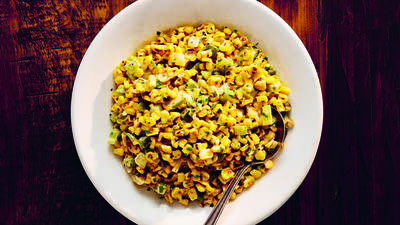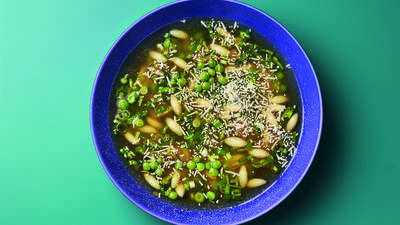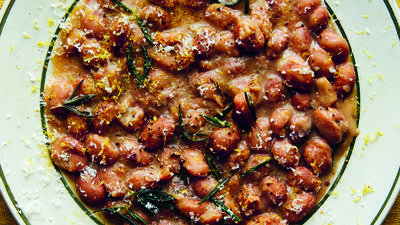
Most of us have some kind of honey in our kitchens, but it’s not always something people reach for while cooking. Usually it’s either gathering dust in the back of a cupboard or simply being stirred into tea or yogurt. Managing Producer Sally Swift asked America’s Test Kitchen host Bridget Lancaster about the different flavors honey can provide, and for some of her favorite ideas for cooking with honey. Trying using your favorite honey in the recipe for Roasted Whole Side of Salmon.
Sally Swift: I want to talk to you about honey. Let’s start with something basic. Can you explain the difference between raw honey and regular honey?
Bridget Lancaster: Sure. You basically have two choices when you go the supermarket; they're now starting to sell raw honey as well as regular. You know the clear fluid that you can see right through? Sometimes it's in a bottle shaped like a teddy bear. That's the regular. That's the kind I grew up with. And then you have raw honey; it's cloudy, you can't see through it at all, and sometimes it's almost white like a butter.
The main difference is how they're treated. Raw honey is not cooked, so it's raw. And if it is cooked a little bit – just up to about 120 degrees – that is mostly so that it can be poured into a container. But raw honey still contains pollen and might have a little bit of the wax still in it that you find from the hive. It's got little crystals; the sugar has started to crystallize in there and that's what turns it that opaque kind of color – for lack of a better word. But the regular honey is the kind that you can see through. It's been heated to a much higher temperature, about 155 or higher, which is almost like pasteurization with milk. They want to kill off any yeast that's in there because the yeast might start to ferment the honey. It also staves off crystallization.
 Bridget Lancaster
Photo: Carl Tremblay
Bridget Lancaster
Photo: Carl Tremblay
SS: Essentially, it's just a cleaned-up version. I know that you guys have tasted some, and they taste different, don't they?
BL: They really do. Wild honey tends to be local, so there are fewer national brands of raw honey. Often, they are what's called monofloral, which means that all the nectar is from one certain type of flower. So, you end up with very specific flavors in the raw honey. Because it hasn't been filtered or heated, the flavors are still there and they’re more rich; you get more of that floral flavor. We really like raw honey.
SS: It has personality.
BL: It does! And you know, sometimes it's a little crunchy. I love that because you can spread it on toast and it's got those little crunchy bits – almost like sea salt. But it's mostly just the sugar starting to crystallize.
SS: And what is the best way to deal with your honey when it gets solid?
BL: Even the regular honey sometimes likes to revert and crystallize and turn solid again. Some people will say that you have to throw it out. Absolutely not! You don't have to throw it out. There are a couple ways to bring it back to that fluid state. One thing you can do is scoop some out, put it in a glass bowl, and microwave it for about 10 seconds at a time. You just want to stir it and make sure that it's heating evenly until it's nice and fluid. Or, if you're going to use a whole bunch, let's say you're making something like a honey cake and you need cups of it at a time, you would just take the container – it has to be a glass container for this to work – put it in a saucepan with a couple inches of water, and heat that over low heat. It'll start to remelt all those crystals and you'll get a beautiful fluid honey.
SS: Can we talk a little bit about those single-flower honeys, like you see tupelo and buckwheat. Do you have an idea for us on what the different varieties taste like?
BL: Usually there's a source on the side of the honey package that will say what types flowers were used, what the source is. You're going to taste whatever the flower was that that honey was made from. So, something like an orange blossom is going to taste very citrusy. Tupelo is a tree and it has kind of a piney flavor, so you're going to get that. We found that buckwheat was actually one of the stronger honeys. It almost has this malty flavor to it, like molasses.
SS: It's darker too, I seem to remember.
BL: It is. And buckwheat itself has protein in it; there are proteins in the honey that react with the sugars, and you end up getting this maltier flavor. It's a very strong flavor. So, if you like a toasty honey flavor it's great. Otherwise, sometimes people like that clean flavor and they want to go with something a milder like tupelo or orange blossom.
 Brush honey onto salmon for a quick and beautiful browing effect in the recipe for Roasted Whole Side of Salmon.
Brush honey onto salmon for a quick and beautiful browing effect in the recipe for Roasted Whole Side of Salmon.
SS: Let’s talk about cooking with honey. When should we be using it?
BL: What people should know is the more you cook honey the less flavor it's going to have. If you're making something like a honey cake you're going to need to use a lot of it in order to get a little bit of flavor. You picture things that are glazed, and I'm not talking like doughnuts, but things that are savory: chicken, pork, fish, things like that. We found that honey was one of the best ways to glaze just about anything. We have a recipe for a whole side of salmon. The piece of salmon itself isn't that thick; it's maybe a half inch or so. The real problem with salmon is overcooking it. If you cook it until it's just done there's almost no color on the top. We went in the kitchen and we were looking for different ways of adding color to the top and getting it to brown quicker.
We tried sugar, because we like sugar, but sugar was really spotty and didn’t work very well. However, honey was kind of amazing. We just brushed it on, it smoothed over the surface perfectly and browned evenly all over. And that has to do with the types of sugar. Regular table sugar itself is basically just disaccharide, meaning it contains two specific sugars to make its own sugar. But honey is a monosaccharide; it’s actually two monosaccharides that are still separate and haven't combined to make sucrose. So, in order for sugar to start to brown it has to break down into those monosaccharides before it can start to brown. That's why honey, because it's already in that state, will brown faster.
 The Sweet Spot for Even Browning: To find the best way to brown the salmon as quickly as possible, America's Test Kitchen coated one portion of the fillet with granulated sugar and another portion with honey and left the remaining portion uncoated. After broiling the fillet, we compared the results. The sugar-coated portion (left) was spotty and almost as pale as the uncoated portion (center), but the honey-coated portion (right) was deeply and evenly browned. Why? The sugars in honey caramelize more rapidly than does white sugar/sucrose, which must first break down into fructose and glucose before it can caramelize.
The Sweet Spot for Even Browning: To find the best way to brown the salmon as quickly as possible, America's Test Kitchen coated one portion of the fillet with granulated sugar and another portion with honey and left the remaining portion uncoated. After broiling the fillet, we compared the results. The sugar-coated portion (left) was spotty and almost as pale as the uncoated portion (center), but the honey-coated portion (right) was deeply and evenly browned. Why? The sugars in honey caramelize more rapidly than does white sugar/sucrose, which must first break down into fructose and glucose before it can caramelize.
SS: Yep, honey's a step ahead. What is the best way for us to keep honey? Does honey go bad?
BL: No. I've never seen honey go bad. I can assume that if you had raw honey that had a large amount of yeast in it, it might start to ferment, but that has never happened to me. For honey we always tell people to store it in a cool spot in your pantry, or you can actually freeze it. Freezing will stop all aging when it comes to honey, but it also stops the crystallization.
SS: And does it get hard? Is it a frozen block?
BL: I call it a squishy solid; it doesn't freeze completely. It's really strange. It’s not like granita where it's almost frozen, but it's not. And it's a good idea, if you are going to store your honey in the freezer, not to store it all in one container. I would probably put it in smaller batches, maybe two tablespoons or even pour it into an ice cube tray. Then just heat it up or let it sit at room temperature when you want. It'll pour beautifully.
Before you go...
Each week, The Splendid Table brings you stories that expand your world view, inspire you to try something new, and show how food connects us all. We rely on your generous support. For as little as $5 a month, you can have a lasting impact on The Splendid Table. And, when you donate, you’ll join a community of like-minded individuals who love good food, good conversation, and kitchen companionship. Show your love for The Splendid Table with a gift today.
Thank you for your support.
Donate today for as little as $5.00 a month. Your gift only takes a few minutes and has a lasting impact on The Splendid Table and you'll be welcomed into The Splendid Table Co-op.




